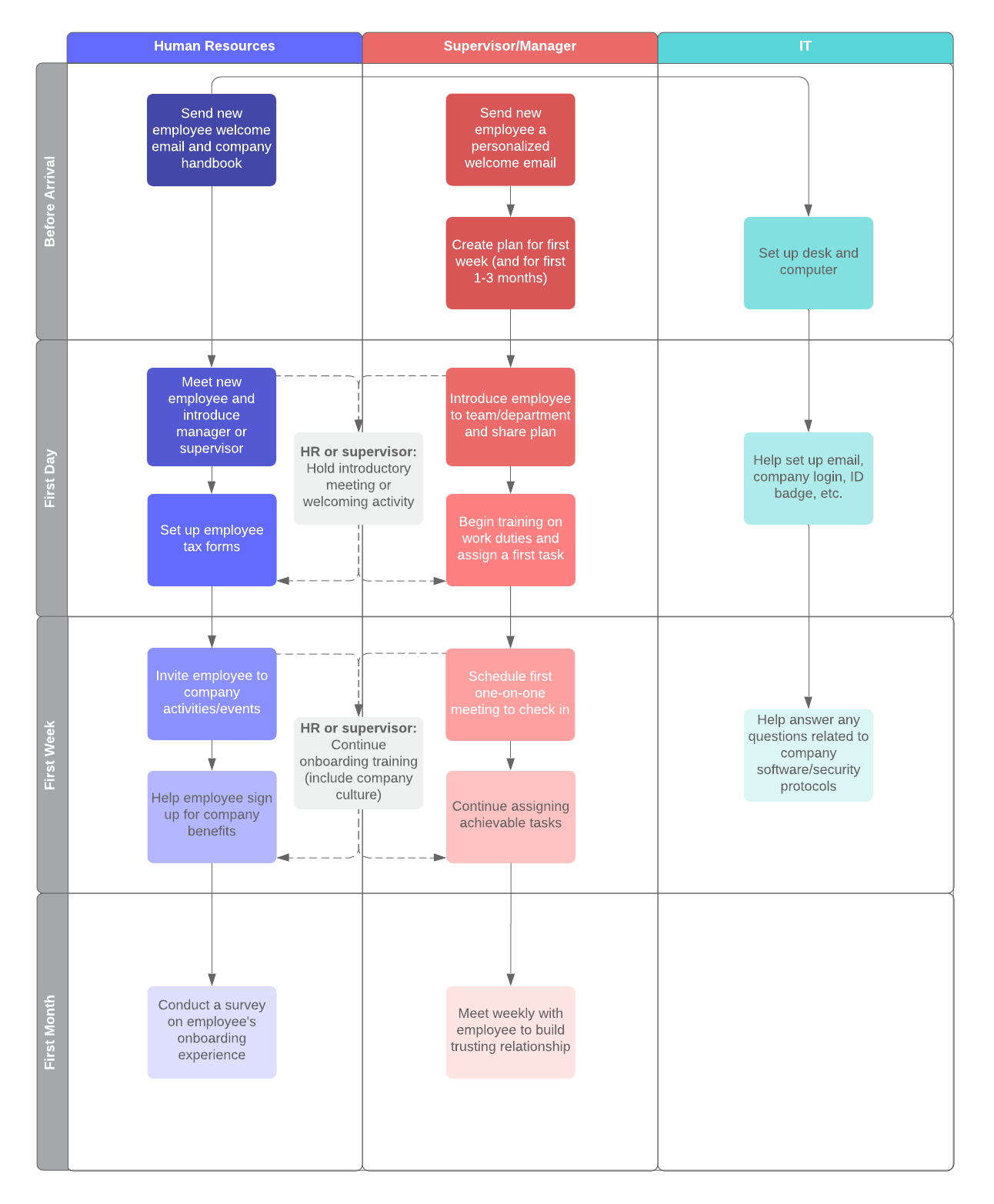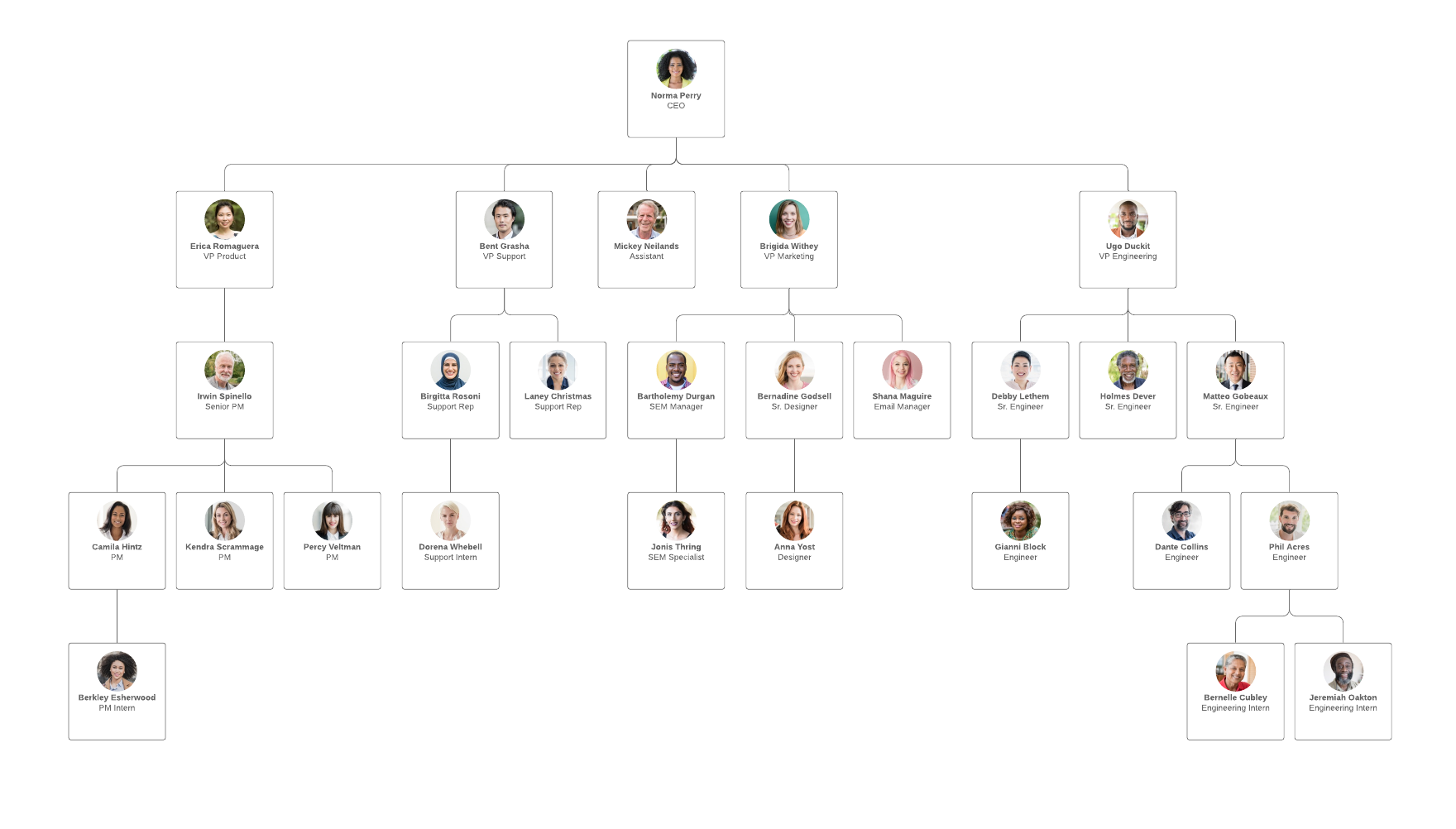
Tips for an effective new employee orientation process
Lucid Content
Reading time: about 8 min
Topics:
According to the U.S. Department of Labor, the average person changes jobs 12 times throughout their career. And each job change comes with a significant investment in time and mental energy—even before signing a contract, an employee can spend weeks, or even months, interviewing for the position to learn about the role and the company culture and determine whether the job is a good fit.
For employers, the investment involved with recruiting new employees is just as high: The average cost of recruiting, interviewing, and hiring an employee averages about 16-20% of the new hire’s annual salary.
This mutual investment illustrates why the new hire orientation process is so important. Often it sets the tone for the new employee’s perception of how organized the company is and how invested they are in their employees.
For employers, a solid orientation process can also significantly boost your retention numbers—the better the new employee orientation, the quicker the employee feels like a part of the team and the less likely they will be to jump ship for somewhere else. According to a study from Glassdoor, organizations with a strong employee onboarding program can improve employee retention by 82% and even boost productivity by 70%. Despite these benefits, 22% of employers still don’t have a new hire orientation process.

What is new hire orientation?
Put yourself in a new hire’s shoes—or better yet, think about the last time you had a first day on the job. Regardless of how many times you’ve transitioned to a new company, the shift can be challenging. There are new systems to log in to, passwords to set, people to meet, and processes to follow.
And then there are the everyday concerns—what’s the best way to commute to the office? Where can I get my morning coffee? What are the good lunch spots nearby? When building an effective new hire orientation format, none of these concerns are trivial.
But what is new hire orientation? Part of the overall employee onboarding process, orientation is typically a one-time event to welcome new hires to the organization on their first day. Employers that make this orientation process seamless and stress-free will do a lot to make new employees feel welcome and comfortable.
Your new hire orientation should include reviews of:
- The company, including history, mission, culture, and current company-wide goals
- Organizational structure and department overviews
- Benefits plans
- Safety, health, and other company policies
- Mandatory new hire paperwork
- Administrative procedures, such as security, logins, available supplies, etc.
Effective new hire orientation ideas
First impressions matter. And the first impression your company makes on the first day of a new hire’s job can make or break their level of commitment. Here are some essential tips to use in new hire orientation process to help ensure your company’s first impression is a good one.
Create a single source of truth for new employees to reference
A consistent orientation process format is critical to ensuring every new employee has a consistent orientation experience. Make it easy for new employees to get all of the information they need to know on the first day in one place and make it engaging.
From org charts and seating charts to process flowcharts, use visuals to create an all-in-one employee resource for your orientation process and help new hires quickly understand the company and its culture. Consider creating a glossary of FAQs for acronyms for quick and easy reference, too. These documents can all be stored in a shared cloud or drive such as Confluence or Google Drive, so they are accessible and easy to reference later.

Allow leadership to introduce themselves to new hires
Create a welcoming environment for new hires by giving each an opportunity to meet those who lead the organization. Meeting and getting to know those in senior positions can be daunting to new employees. During orientation, have leadership and senior positions come and introduce themselves to all new hires.
Have them walk through their roles and teams in the company. Use org charts to show where they and everyone fits into the overarching organizational structure. It's a simple step in the orientation process, but it can go a long way to instilling a culture of inclusion at your company.

Make your company’s organizational chart the best, all-in-one resource for your employees with Lucidchart.
Learn howBreak the ice with new hires
It can also feel intimidating for new employees to break into existing workplace social circles. Recent polls have found that quality friendships at work have a direct link to job satisfaction and engagement. Employee satisfaction skyrockets nearly 50% when a worker develops a close relationship on the job. Employers can capitalize on this effect by making a proactive effort to get new hires involved in company culture.
For example, before you send new hires into a conference room for hours of training, give them the opportunity to see their new workspace and meet their co-workers. And beyond orientation day, give new and tenured employees a chance to break the ice and get to know each other, whether it’s a monthly new hire lunch or an after-work event.
Break up meetings
Although new hire orientation often happens in one day, avoid overwhelming new hires with too many facts at once. Split up the content over time, use visuals to show key information, and schedule breaks in between meetings so that information is easier to digest and remember.
Ask for feedback
Recognize that you will need to continuously iterate on and improve your orientation process to set new employees up for success. After orientation, send out a survey to new hires or ask them directly to provide feedback. Talk to people managers as well to gauge whether new hire orientation effectively prepared these new employees to fulfill their roles and follow company policies.
Key benefits of building an orientation process
To put it simply, a solid new hire orientation process will boost your bottom line. Thoughtful and thorough employee onboarding will increase retention, boost productivity, and improve your company’s culture.
Reduce employee turnover
58% of employees who go through a structured orientation process are more likely to still be with the company after three years. When you take into account all of the time, money, and energy that goes into recruiting new employees, it makes sense to invest your dollars on the employees who are already in the door, so you are less likely to have to keep recruiting new ones.
When you increase retention, you also make your company orientation a lot easier: Employees who have been with the company for longer can help train new employees and make them feel welcome. If your retention numbers are low, on the other hand, employee onboarding becomes all that much harder.
Boost productivity
A study by the Aberdeen Group found that 15% of respondents cited a lack of orientation processes as contributing to their decision to quit. The same group also found that 62% of companies with onboarding programs reported a higher time-to-productivity ratio. New hire orientation and onboarding is the perfect time to make sure the employee is aware of their responsibilities and to give them a safe space to ask questions and, more importantly, to have those questions answered quickly.
For new hires, the most frustrating part of a job can be figuring out who to ask questions to and, depending on the company culture, how to ask questions. An effective orientation process will make a new hire’s time more productive by getting them up to speed quickly on internal processes.
Improve company culture
While the orientation process for new hires can offer a safe space to ask questions related to internal processes, it can also be a way to share more about the company’s culture. Maybe you have annual retreats where you bring in industry thought leaders or employees have a book club that meets every month.
Following an orientation process can be an excellent way to help new hires feel welcome and connect to the company in ways that align with their passions. By making new hires feel welcome on day one, it’s much more likely that they will feel supported and ready to excel.
Visualize your orientation process with Lucidchart
Throughout the orientation process for new employees, visuals can help them quickly grasp and understand new concepts and company information. You can create flowcharts and process maps using Lucidchart to better illustrate the orientation process, as well as your company and its culture. Along with helping new hires become acquainted with your company, our visual workspace can also help HR and IT departments better prepare for these incoming employees, such as mapping out processes for provisioning hardware.
With diagrams that are storable in Google Drive, Confluence, and other apps for future reference or self-guided orientation training, Lucidchart helps you streamline the orientation process, improve employee satisfaction, and boost your bottom line.

Visualize your new employee onboarding process to create a seamless experience for new hires.
Learn howAbout Lucidchart
Lucidchart, a cloud-based intelligent diagramming application, is a core component of Lucid Software's Visual Collaboration Suite. This intuitive, cloud-based solution empowers teams to collaborate in real-time to build flowcharts, mockups, UML diagrams, customer journey maps, and more. Lucidchart propels teams forward to build the future faster. Lucid is proud to serve top businesses around the world, including customers such as Google, GE, and NBC Universal, and 99% of the Fortune 500. Lucid partners with industry leaders, including Google, Atlassian, and Microsoft. Since its founding, Lucid has received numerous awards for its products, business, and workplace culture. For more information, visit lucidchart.com.
Related articles
Hiring to Avoid Firing: Improving the Human Resources Life Cycle
Firing is the worst. Use these tips and free templates to visualize and improve your human resources lifecycle.
How to set up effective onboarding with Lucidchart
More and more organizations are looking to move their onboarding processes online—and Lucidchart is the perfect platform to do so. See how you can visualize your onboarding process, give new employees easy-to-understand documentation, and track new hires' progress.